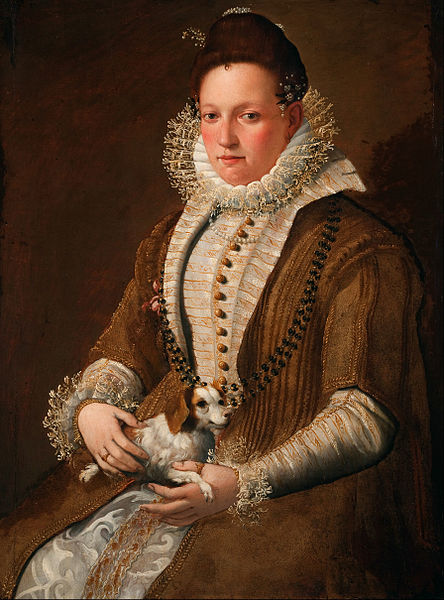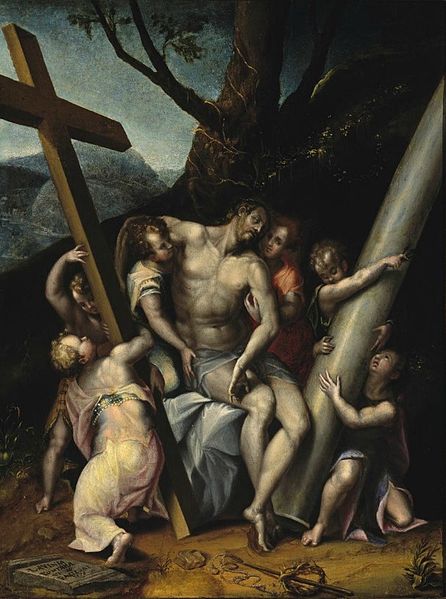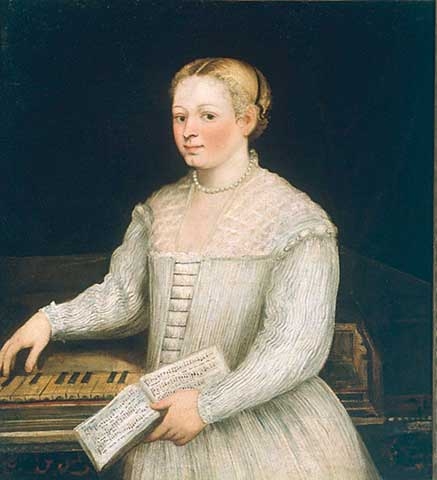3.4: Mannerism Art
- Page ID
- 183169
\( \newcommand{\vecs}[1]{\overset { \scriptstyle \rightharpoonup} {\mathbf{#1}} } \)
\( \newcommand{\vecd}[1]{\overset{-\!-\!\rightharpoonup}{\vphantom{a}\smash {#1}}} \)
\( \newcommand{\id}{\mathrm{id}}\) \( \newcommand{\Span}{\mathrm{span}}\)
( \newcommand{\kernel}{\mathrm{null}\,}\) \( \newcommand{\range}{\mathrm{range}\,}\)
\( \newcommand{\RealPart}{\mathrm{Re}}\) \( \newcommand{\ImaginaryPart}{\mathrm{Im}}\)
\( \newcommand{\Argument}{\mathrm{Arg}}\) \( \newcommand{\norm}[1]{\| #1 \|}\)
\( \newcommand{\inner}[2]{\langle #1, #2 \rangle}\)
\( \newcommand{\Span}{\mathrm{span}}\)
\( \newcommand{\id}{\mathrm{id}}\)
\( \newcommand{\Span}{\mathrm{span}}\)
\( \newcommand{\kernel}{\mathrm{null}\,}\)
\( \newcommand{\range}{\mathrm{range}\,}\)
\( \newcommand{\RealPart}{\mathrm{Re}}\)
\( \newcommand{\ImaginaryPart}{\mathrm{Im}}\)
\( \newcommand{\Argument}{\mathrm{Arg}}\)
\( \newcommand{\norm}[1]{\| #1 \|}\)
\( \newcommand{\inner}[2]{\langle #1, #2 \rangle}\)
\( \newcommand{\Span}{\mathrm{span}}\) \( \newcommand{\AA}{\unicode[.8,0]{x212B}}\)
\( \newcommand{\vectorA}[1]{\vec{#1}} % arrow\)
\( \newcommand{\vectorAt}[1]{\vec{\text{#1}}} % arrow\)
\( \newcommand{\vectorB}[1]{\overset { \scriptstyle \rightharpoonup} {\mathbf{#1}} } \)
\( \newcommand{\vectorC}[1]{\textbf{#1}} \)
\( \newcommand{\vectorD}[1]{\overrightarrow{#1}} \)
\( \newcommand{\vectorDt}[1]{\overrightarrow{\text{#1}}} \)
\( \newcommand{\vectE}[1]{\overset{-\!-\!\rightharpoonup}{\vphantom{a}\smash{\mathbf {#1}}}} \)
\( \newcommand{\vecs}[1]{\overset { \scriptstyle \rightharpoonup} {\mathbf{#1}} } \)
\( \newcommand{\vecd}[1]{\overset{-\!-\!\rightharpoonup}{\vphantom{a}\smash {#1}}} \)
Introduction
Maniera in Italian was a new style, Mannerism, moving from the classical versions of the Renaissance, bringing images less focused on the beauty of balance and perfect symmetry to elongated features with expressive and unusually positioned figures. Instead of an idealized and harmonious portrayal, Mannerism artists used dissonance, imbalance, and ambiguous figures. The style started in Florence and Rome and moved throughout Italy as a counter position to the formal style and idealism defined by the Renaissance artists and moved to unusual or contrived positioning in bizarre juxtapositions. Colors were placed in strange places using light to determine exaggerated contrast. Some later Renaissance painters displayed Mannerism styles in Michelangelo's The Last Judgment with oddly muscled characters in tortured positions. The Mannerism style was found in sculptures and paintings with complex poses and details.
- Barbara Longhi (1552-1638)
- Lavinia Fontana (1552-1614)
- Marietta Robusti (1560-1590)
Barbara Longhi
Barbara Longhi (1552-1638) was an Italian artist from Ravenna and the daughter of a Mannerist painter (Luca Longhi). She worked in their father's studio, assisting on large altarpieces, and became a respected portrait painter. Although little is known about her life, there are approximately 14 paintings attributed to Longhi. The painting Saint Catherine of Alexandria (3.5.1) is considered a self-portrait, the only one surviving.
Of Longhi's portrayal of herself as the aristocratic, cultured Saint Catherine of Alexandria, Irene Graziani writes, "When she exhibits an image of herself, Barbara, too, is presented according to the model of the virtuous, elegant and erudite woman, revisiting the themes which Lavinia [Fontana] had developed several years earlier in Bologna, according to a repertoire tied to late Mannerism."[1] The decidedly familiar Renaissance painting style is combined with early Mannerism displaying a darker background illuminating the figure. The yellow blouse and light skin tones are accentuated against the brown background, and the light source is evident from the left. Longhi's influences on art gave way to a long list of artists like Raphael and Anguissola, inspiring up-and-coming artists.

Barbara Longhi was born on 21 September 1552 and died 23 December 1638. she was an Italian painter. She was much admired in her lifetime as a portraitist, although most of her portraits are now lost or unattributed. Her work, such as her many Madonna and Child paintings, earned her a fine reputation as an artist. The simplicity of composition and subtle color palette used in her paintings also reflect the doctrines of the Counter-Reformation. Her relatively minor works, as opposed to the large altarpieces created by her father, indicate their intended emphasis on devotional thoughts. She sought to evoke empathy in the viewer with her subjects. She resisted the trend to create huge Biblical scenes, instead concentrating on serene depictions of the Virgin and Child.
Lavinia Fontana
Lavinia Fontana (1552-1614) was considered a Bolognese Mannerist painter working in Bologna and Rome. She learned to paint from her father (Prospero Fontana), an art teacher at the School of Bologna. Fontana is regarded as the first female career artist in Western Europe as she relied on commissions for her income [2] while her husband raised their eleven children. She even had her husband sign a pre-nuptial stating she would continue painting and live in her family home. While her counterparts painted in court settings or convents, Fontana competed with male contemporaries on the open market, paving the way for other female artists.[3] She was considered the first woman who worked as an artist like other major male artists, operating her studio, attending schools, working on commissions, and painting in various genres. It was common for female artists to paint portraits, especially of other females, and Fontana did many portraits. Still, she reached beyond the standard practice and painted significant works with mythological or religious themes, even adding nude females, an unheard-of image for a woman painter. She had eleven children, earned a doctorate at the University of Bologna, was admitted to the academy, became famous, and was commissioned by the pope to paint images for his court.
Fontana painted roughly 110 paintings, including 23 altarpieces around Northern Italy. Supporting her family was a rare accomplishment; however, she had help from her hometown of Bologna. The town housed a liberalizing academy, an uncommon political organization, and diverse artistic patronage from the middle class, supporting women artists.[4] Bologna was a democratic city run by a diverse senate that wanted to patronize artists. Women had access to education at a university located in town, of which Fontana was an alumnus.
Fontana was well known for her detailed portraits of women, particularly her successful painting of lace and jewelry and the often-difficult images of hands. The subject of Lady with a Dog (3.5.2) is unknown; however, the focus of the painting was the display of the wealth and qualities of a good wife. She sits with her dog, a symbol of fidelity, in her elaborate and detailed clothing depicting a wealthy wife. Men were portrayed as statesmen, military leaders, or in other fields; a woman could only display her dress as an accomplishment. One of Fontana's unusual paintings was Portrait of the Gozzadini Family (3.5.3), a work commissioned by the woman in the red skirt. Although there are five people in the painting, two of the people, her deceased father and sister, were included in the portrait. The two figures standing were her husband and brother-in-law, the executors for her father's estate, an inheritance she hoped to obtain. Both women are wearing the exquisite clothing Fontana is known to paint with great detail. On the table is the requisite dog demonstrating the fidelity of the wife.


Christ with the Symbols of the Passion (3.5.4) displays Fontana's Mannerism style; twisted figures crowd around the oversized Christ. The influence of the recent Renaissance period is reflected in the landscape background, a specific part of a Renaissance painting. The sky is offset instead of in the center. The heads of each image are small and out of proportion with the bodies. The panel's painting is miniature and would generally be for private devotion.
According to the Catholic Church, of the 23 altarpieces Fontana painted, the Assunzione della Vergine (3.5.5) is a classical scene of the ascension. An allegorical Virgin Mary rises between earth and heaven, ascending into God's hands, dressed in the typical red gown and dark blue robes. The blue sky gives way to the glowing aura from heaven above while several Putti (angels) guide her up to paradise. Fontana moved to Rome at the invitation of Pope Clement VIII, and her career soared. She received numerous awards and honors and was elected to the Accademia di San Luca in Rome.


A video of the tradition of religious paintings as teaching tools. The El Paso Museum of Art is home to some of the Kress Collection of European art. This assortment of videos brings part of the collection to life through a series of animations completed by UTEP’s digital media production students and alums.
Go behind the scenes in the National Gallery of Ireland's conservation studio, and discover the team's detailed research and skillful treatment of Lavinia Fontana's monumental painting 'The Visit of the Queen of Sheba to King Solomon.' An early addition to the Gallery’s permanent collection, 'The Visit of the Queen of Sheba to King Solomon' is the largest surviving and most ambitious painting ever made by one of the most renowned artists of the Renaissance.
Marietta Robusti
Marietta Robusti (1560-1590) was a Venetian painter and the daughter of the famous Venetian painter, Tintoretto, and she is occasionally referred to as la Tintoretto (little dyer girl). She lived in Venice and died at 30 years during childbirth. At the time, women remained at home and were not welcome in the art world. Women painters were usually the decedents of painters and therefore had access to materials and learning from her father.
Self-portrait with a Spinet (3.5.6) is the only painting accurately attributed to Robusti. Painted in the tradition of contrasting light and dark, the three-quarter figure depicts a young woman with one hand lightly caressing a harpsichord behind her while the other holds a songbook. The slightly turned body wears a dress of white lace with a necklace of pearls, the head displaying a sideways glance, indicating the portrait was painted in front of a mirror. Although sometimes her portraits were considered stiff and unnatural, she had an eye for details and could realistically paint any jewelry or clothing.
Because Robusti was taught by her father and worked closely with him in the workshop, her style was similar to Tintoretto's. She was known to create a significant set of paintings, mainly portraits. However, little of her work is identified as hers. It is unknown if she didn't sign her work, if it is misidentified as her father's work, or if it was lost over the centuries. The other surviving painting attributed to Robusti is a Portrait of Two Men, signed with the initials MR. A few other small religious images are also attributed to her. In a time when women were legally their husband's property, required to take on the typical housewife role, focusing on her husband and children, Robusti was an accomplished artist and well sought after in her own right for commissions.

The lost paintings of Marietta Robusti are a maddening Renaissance mystery.
[1] Ceroni, Nadia (2007). "Barbara Longhi." In National Museum of Women in the Arts (ed.). Italian Women Artists from Renaissance to Baroque. Milan, Italy: Skira Editore S.p.A. ISBN 978-88-7624-919-8.
[2] Murphy, C. (2003). Lavinia Fontana: A painter and her patrons in sixteenth century Bologna. New Haven, CT. Yale University Press. (p. 30).
[3] Chernick, K. (2019). How women artists flourished in Northern Italy during the renaissance. (10). https://hyperallergic.com/522392/wom...vinia-fontana/
[4] Ibid.

